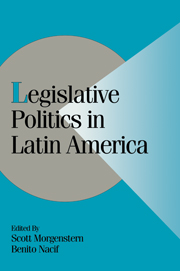Book contents
- Frontmatter
- Contents
- Tables and Figures
- Contributors
- Preface and Acknowledgments
- Party Names and Other Acronyms and Abbreviations
- 1 TOWARDS A MODEL OF LATIN AMERICAN LEGISLATURES
- Part I Executive–Legislative Relations
- Part II Political Parties and Legislative Structure
- Part III Legislatures and the Policy Process
- 10 FISCAL POLICY MAKING IN THE ARGENTINE LEGISLATURE
- 11 PROGRESSIVE AMBITION, FEDERALISM, AND PORK-BARRELING IN BRAZIL
- 12 APPOINTMENT, REELECTION, AND AUTONOMY IN THE SENATE OF CHILE
- 13 THE LEGAL AND PARTISAN FRAMEWORK OF THE LEGISLATIVE DELEGATION OF THE BUDGET IN MEXICO
- Part IV Conclusions
- References
- Author Index
- General Index
12 - APPOINTMENT, REELECTION, AND AUTONOMY IN THE SENATE OF CHILE
Published online by Cambridge University Press: 14 January 2010
- Frontmatter
- Contents
- Tables and Figures
- Contributors
- Preface and Acknowledgments
- Party Names and Other Acronyms and Abbreviations
- 1 TOWARDS A MODEL OF LATIN AMERICAN LEGISLATURES
- Part I Executive–Legislative Relations
- Part II Political Parties and Legislative Structure
- Part III Legislatures and the Policy Process
- 10 FISCAL POLICY MAKING IN THE ARGENTINE LEGISLATURE
- 11 PROGRESSIVE AMBITION, FEDERALISM, AND PORK-BARRELING IN BRAZIL
- 12 APPOINTMENT, REELECTION, AND AUTONOMY IN THE SENATE OF CHILE
- 13 THE LEGAL AND PARTISAN FRAMEWORK OF THE LEGISLATIVE DELEGATION OF THE BUDGET IN MEXICO
- Part IV Conclusions
- References
- Author Index
- General Index
Summary
Introduction
Biologists can learn a great deal about plants and animals by studying how they adapt to harsh “fringe” habitats such as the desert or the tundra, evolving body structures that either shed or conserve heat, and coloration that blends into the background hues of scorched earth or snow. In a similar way, students of legislative politics can learn a great deal by studying legislatures in the “fringe habitat” of an ongoing democratic transition.
The Chilean Senate exists on the edge of democracy, operating under a constitution written in 1980 under the auspices of that country's former military government. The Senate includes 38 elected members, and during the period under study it also included 8 or 9 nonelected senators appointed by the departing military regime. The “binominal” system used to choose the elected senators has some “fringe features” of its own: it virtually guarantees that the party list that comes in second in each of the two member Senate districts gets one of the two seats in contention. Between the appointed senators and the electoral system, legislators friendly to the former military government control a majority of the Senate. The opposition-controlled Senate looms over the legislative process like a robber baron's castle overlooking the Rhine, and legislative initiatives must stop and pay tribute.
While the rules for choosing its members were designed to produce a Senate majority sympathetic to the former military government, they have the unintended side effect of creating a “natural experiment” on the impact of selection rules on legislative behavior. In this chapter I compare the voting records of the appointed senators with the corresponding votes of their elected counterparts to assess several hypotheses about the legislators' motives.
- Type
- Chapter
- Information
- Legislative Politics in Latin America , pp. 341 - 376Publisher: Cambridge University PressPrint publication year: 2002
- 16
- Cited by



